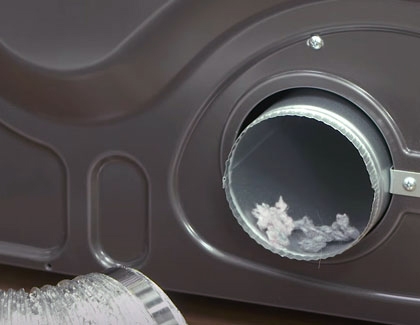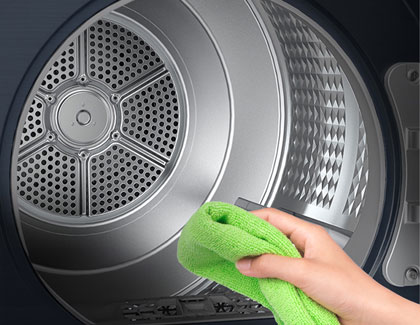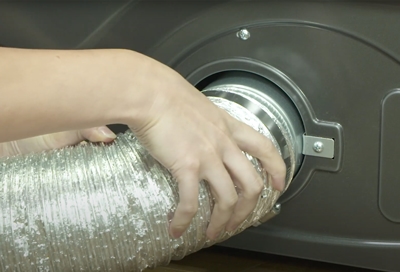How to clean your Samsung dryer
Dryers can become potentially dangerous appliances if not kept clean. With a little routine maintenance, you can limit risks, and even keep your energy cost lower. In addition to cleaning your lint filter and exhaust vent, you'll want to check the drum for surprise messes. A forgotten pocket pen or crayon can cause a mess you'll want to clean before putting in another load.

How to clean your Samsung dryer
Clean the lint filter before or after every load
Cleaning the lint filter is easy. Open the door, and then pull out the lint filter from inside the drum. Remove the lint that has accumulated inside the space. You can use a pipe cleaner to clear out the lint filter compartment. Clean the lint off the filter, reinsert the filter, and then close the door.
If you need to replace your lint filter, visit Samsungparts.com.
If you're only going to clean it before or after a cycle, we recommend before since it will mean less lint for your dryer to deal with. However, both is better. It never hurts to have as little lint as possible in your lint filter.

Clean the sensor bars when Sensor Dry cycles are too short
Sensor Dry cycles use the bars on the inside of the dryer drum that detect moisture, and stop the cycle when moisture is no longer detected. This is an easy way to run the cycle only as long (or as short) as needed to get the clothes dry, and save energy.
However, if you use dryer sheets frequently, a residue can build up on the sensor bars that prevents them from detecting moisture, so the dryer perpetually thinks the load is dry and ends cycles too soon. The bars may also get dirty and work less effectively.
Fortunately, the sensor bars can be easily cleaned with a soft cloth and mild soap, then dried off with a towel or other cloth.
Clean your exhaust vent once or twice per year

When it comes to cleaning your dryer’s exhaust vent, a professional vent cleaning service is recommended. However, if you are determined to do it yourself, please use the following tips and steps.
Required tools
- Vent cleaning kit with brush, extension rods, and adapter attachments for drill and vacuum
- Drill
- Screw driver
- Vacuum
- Pliers
- Tape (to secure the extension rods and avoid losing them inside the vent)
First, turn off the gas (if you have a gas dryer), and unplug the dryer from its power source.
If possible, disassemble the external vent outside of the house and remove any lint from the vent cover.
Disconnect the flexible or semi-rigid duct from the floor or wall attachment. This is usually accomplished by removing the clamp.
Assemble the cleaning kit by following its directions and attach it to the drill.
Insert the brush into the vent, and slowly rotate it with the drill set to clockwise. (Otherwise, the attachments may disconnect from the drill.)
Add extension rods as needed until the brush reaches all the way through the vent. You may want to tape the rod connections, so that they do not get lost or stuck inside the vent.
Inspect the duct for damage. If it's damaged, you'll need to replace it. If you are not replacing it, gently clean the duct with the brush attachment.
Vacuum any lint and debris.
Reconnect the duct to the dryer.
Put the dryer back into place and plug it in.
Reassemble the exterior vent.
Turn the gas back on (for gas dryers).
Clean the drum when necessary

Most of the time, you don't have to worry about moisture piling up in your dryer as long as you don't let wet clothes sit before starting the cycle. Wet or damp clothes can cause a mold or mildew smell to linger around the inside of the dryer, and you'll want to prevent that from happening.
Additionally, something might spill or stain your dryer (like a crayon or pen left in a pocket) so you may still need to clean your dryer's drum now and then.
If your dryer's drum is powder coated, you can remove stains from it with an all-purpose cleaner. Then, use some old towels or rags and tumble them through a dry cycle. They'll collect the remaining stains or cleaner. Even if stains are left on your drum after that point, they won't get on your clothes anymore.
To clean a stainless steel drum, use a damp cloth with a mild, non-abrasive cleaner suitable for easily marred surfaces. Then, remove the cleaner residue and dry with a clean cloth.
Clean the control panel and exterior when necessary

You may want to clean the outside of your dryer and the control panel to remove any dust, lint, or fingerprints.
Always use a soft cloth when cleaning the control panel; you may dampen it if needed. Do not spray liquid cleaning agents or laundry stain removers directly onto the display, as they could cause damage. If you choose to use a liquid cleaner, make sure to apply a small amount onto the cloth first, and immediately wipe up any spills.
When cleaning the dryer’s exterior, use a soft, damp cloth and avoid using any abrasive products. Your dryer has a high-gloss finish that can be scratched by rough cleaners and sharp or heavy objects.






